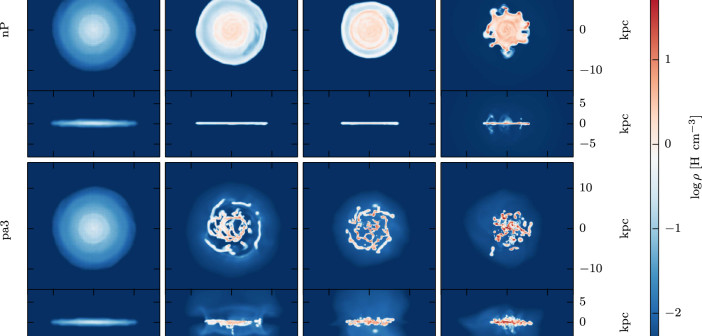Extremely high star formation rates have been observed in galaxies at high redshifts, posing somewhat of a mystery: how are these enormous rates achieved? A team of scientists has proposed that these high rates of star formation could be explained by feedback from active nuclei at the centers of the galaxies.
Pressurized Bubble
We believe that star formation occurs in galaxies as a result of gas clumps that collapse under their own gravity, eventually becoming dense enough to launch nuclear fusion. Recently, there’s been mounting evidence that the star formation rate is significantly higher in high-redshift galaxies, particularly those with active galactic nuclei (AGN). Could this simply be caused by a higher gas fraction at higher redshifts? Or is it possible that a different mechanism is at work in these galaxies, producing more efficient star formation?
A team of authors led by Rebekka Bieri (Paris Institute of Astrophysics) has proposed that this enhanced star formation may be caused by positive feedback from the active nucleus of the galaxy. The team suggests that an outflow from the AGN could create an over-pressurized bubble around the galactic disk that pushes back on the disk, leading to a higher rate of star formation.
Simulating a Boost
The authors test this toy model by simulating the scenario. They model a disk galaxy with roughly a tenth of the mass of the Milky Way, which starts in a relaxed state. The galaxy is then evolved either with or without an applied external pressure, representing the isotropic pressure from the bubble created by the AGN outflow. These models are tested in two different scenarios: one where the initial gas fraction is 10%, and one where the initial gas fraction is 50%.
![Star formation rates for the low-gas-fraction (left) and high-gas-fraction (right) simulated galaxies. The blue lines show the rates without external pressure; the red lines show the rates with external pressure applied. Click for a better look! [Bieri et al. 2015]](https://aasnova.org/wp-content/uploads/2015/10/fig31-260x118.jpg)
Star formation rates for the low-gas-fraction (left) and high-gas-fraction (right) simulated galaxies. The blue lines show the rates without external pressure; the red lines show the rates with external pressure applied. [Bieri et al. 2015]
Bieri and collaborators also track the mass entering and leaving the galactic disk during the simulation. When external pressure is present, it drives a large net mass inflow at the beginning of the simulation, carrying in material from the halo and outer disk. This early source of mass helps to feed cloud and clump growth in the inner parts of the galaxy — contributing to the increased star formation rate in the pressurized cases.
Thus, this simple model has demonstrated that enhanced pressure due to AGN feedback is an effective means of explaining the large star formation rates we observe in high-redshift galaxies.
Citation
Rebekka Bieri et al 2015 ApJ 812 L36. doi:10.1088/2041-8205/812/2/L36

1 Comment
Pingback: feedback from AGN outflows enhance star formation rates